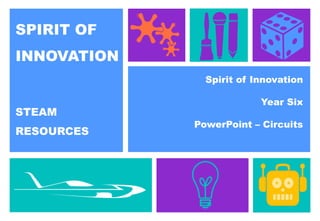
PowerPoint Circuits (1).pptx
- 1. SPIRIT OF INNOVATION STEAM RESOURCES Spirit of Innovation Year Six PowerPoint – Circuits
- 2. Electricity can be made in a variety of ways, for example: Electricity Burning fossil fuels (oil, gas, coal) at power stations Using wind power generated by wind turbines Using solar power generated by the sun Using water power (sometimes called hydropower) generated by running or falling water. Electricity is transported to our homes, schools and places of work through wires and cables.
- 3. A cells converts chemical energy into electrical energy by a chemical reaction. Usually the chemicals are kept inside the cell. It is used in a circuit to power other components. A cell produces direct current (DC) electricity (electricity that flows in one direction, and does not switch back and forth) Electrical circuits are built from many different components. These components perform different functions. Some electrical components include: cells, bulbs, motors, buzzers and wires. Circuits +
- 4. Lamps are commonly called light bulbs. An electric lamp encloses a thin metal filament that emits light (and heat) when an electric current is passed through it. This filament is covered by a glass bulb containing a gas, such as argon or nitrogen. Circuits On Off
- 5. An electrical switch is used to interrupt the flow of electrons in a circuit. Switches are either completely on (closed) or completely off (open). Then the switch is closes electricity is able to flow around the circuit. Circuits Open – no electricity can flow Closed – electricity can flow
- 6. A wire is a long thin piece of metal that is used to carry electric current. Most wires often has an inner core made of a material that conduct electricity and an outer coating that is an insulator, often plastic. Circuits
- 7. The motor in a machine is the part that uses electricity or fuel to produce movement. E.g. it converts electrical power into mechanical power. A buzzer is an electrical device that creates a buzzing sound when electricity passes through it. Circuits M
- 8. A V A voltmeter is an instrument used for measuring electrical potential difference between two points in an electric circuit. Circuits An ammeter (from Ampere Meter) is a measuring instrument used to measure the current in a circuit. Electric currents are measured in amperes (A), hence the name. Current: this is the amount of electricity flowing through the circuit (basically a flow of electrons moving in a loop in the circuit). It can be measured using an ammeter and measured in amps. Voltage: is the difference in electrical energy between two parts of a circuit. It can be measured using a volt meter and is measured in volts. The bigger the voltage, the bigger the current. Large electrical items need a higher electrical voltage and current than smaller items
- 9. + M Match the symbol to the image
- 10. A circuit is a route in which electrical current can flow. Here we can see the electrons moving from the negative side of the battery towards the base of the bulb. The electrons flow up the wire inside the bulb and across the filament. Here the some of the electrical energy changes to heat and light energy. The electrons continue down another small wire inside the bulb and to the conductive side of the bulb. The then continue to the positive side of the battery. The electrons have now travelled a complete circuit. Without a complete circuit the electrons cannot flow.
- 11. Series Circuit The current flows the same, from one component to another. If a bulb is removed the circuit will be broken, as the electrons stop flowing. When you plug in that second, third bulb, they will become equally dim. More resistance has been added to the circuit, which decreases the flow of current, as the battery has more work to do.
- 12. Rank these circuits; starting with the brightest bulb and ending with the dullest bulb. Give reasons for your answer.
- 13. Parallel Circuit If a bulb is removed the electrons will continue to flow, as each bulb has its own circuit. In a parallel circuit the bulbs will remain bright, but it will drain the battery power quicker. Components connected in parallel are connected along multiple paths so that the current can split up; the same voltage is applied to each component.
- 14. These resources have been brought to you by
